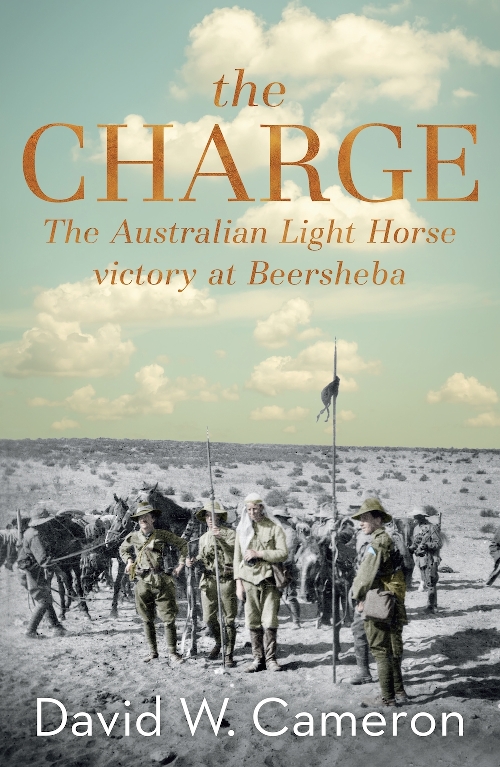Major General Harry Chauvel served in the Boer War before being appointed commander of the 1st Australian Light Horse Brigade (1st ALH) to lead his dismounted troops on Gallipoli. A shy man, he gained the respect of his men by his halting of the futile commitment of his troops at The Nek (August ’15). In mid-March 1916, he led the new Anzac Mounted Division of ALH, NZLH and British Yeomanry. The Charge follows the actions of the Allies on the Sinai Peninsula from the Suez Canal to the action in Palestine at Beersheba eighteen months later.

Paperback 400 pp RRP: $35.00
The Australians’ horses were Walers – crosses between British thoroughbred mares and draught horses. They required about 10kg of fodder and 20 litres of water daily to maintain stamina and fitness, so logistics placed limitations on what the Light Horse could undertake tactically.
Allocated adequate troops and resources Chauvel was able to capture Romani and El Arish (Aug ’16), Magdhaba (Dec ’16) and Rafa (Jan ’17). As a result of these victories Chauvel was knighted in January 1917. Eager to push further north towards Jerusalem, the next objective was Gaza. The Egyptian Expeditionary Force (EEF) had pushed both a railway and pipeline to within striking distance of Gaza. Lieutenant Frank McNamara of the Australian Flying Corps (AFC) was awarded the first Victoria Cross of the Palestine campaign on 20th March just prior to the planned attack on Gaza.
The first battle for Gaza on 26 March 1917 finally commenced almost five hours after its planned launch. Having circled the town to prevent reinforcing of the garrison, it had to be taken before nightfall. A maze of thick cactus hedges, far more effective than barbed wire, confronted the infantry. Chauvel’s Division had elements secure the town centre by dusk, but was then ordered by Chewed, the British commander, to withdraw because of a large force heading south to reinforce the Turkish garrison. Flight Commander Richard Williams of the AFC informed the commander that he had spotted a small force too far away to influence the battle – it was not even noted and dismissed with a ‘That’s interesting’. A post-War British review of the battle concluded ‘. . . [It] should become a classic example of a battle won by troops, but lost by staff.’
As a result, the Turks heavily reinforced Gaza with strengthened defences and many more troops. The second battle on 19th April was hard-fought but unsuccessful. In May Chauvel took over the Desert Column, later known as the Desert Mounted Corps, thereby becoming the first Australian to command a corps, and the first to reach the rank of lieutenant general. The Turks had established a line from Gaza eastward to Beersheba, and after considerable deception and substantial preparation (mainly at night) for an assault on Beersheba at the eastern end of the line, the EEF had the Turks believing that a third assault would be made on Gaza. The 31st October attack was designed to render Turkish occupation of Gaza untenable, and then to destroy their forces in detail.
Again, the capture was to be completed before dark to consolidate the position and water overstretched men and horses. Chauvel planned to attack Beersheba after Tel el Saba to its east had been taken, but when it had not and only two hours of light remaining, he ordered Brigadier Grant (4 ALH Brigade) to use the rested and watered 4th and12th ALH Regiments to charge Beersheba and seize its pumping plant and wells. With bayonets fixed to their rifles (sabres were not issued until 1918), the regiments set out at a trot at 4:30pm across four kilometres that whilst open, had no barbed wire between them and the Turks. Engaged by ineffective artillery and machine gun fire because the Turks failed to lower their weapon sights as the cavalry drew nearer, the Regiments reached the Turkish trenches with very few casualties, before affecting Beersheba’s capture with some daylight to spare. At 5:30pm German aircraft bombing the 8th ALH caused it CO, Lieutenant Colonel Leslie Maygar, VC to be struck by shrapnel that led to his death next day. Within five weeks Jerusalem was in British hands.
Cameron has described the ‘forgotten’ war in a most readable fashion. It is free of military jargon, contains easy-to-follow maps of the major battles, and contains many short first-hand accounts of different scenarios. Extracts from Chauvel’s letters to his wife, comments from Major ‘Banjo’ Paterson and Trooper Ion Idriess and many others help transport the reader to being there one hundred years ago. Three short inclusions devoted to the bond between man and his horse make an appropriate tribute to the 160,000 horses that left Australia and were never to return. There is an excellent collection of photographs, Comprehensive Notes, Reference lists and two indices – people, places, and events; and military units.
A work that should be in all libraries and that military history buffs should read before the centenary of ‘The Charge’ is celebrated.
Reviewed for RUSIV by Neville Taylor, July 2017
Contact Royal United Services Institute about this article.






